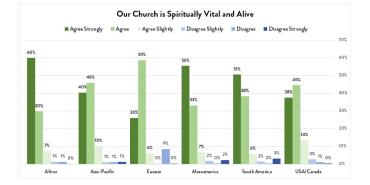Media in the Church of the Nazarene

Media in the Church of the Nazarene took root during an era in the church when you could make movies, but you couldn't go to one. At the time, stained glass windows were okay in a sanctuary, but a projected image wasn't. Television was beginning to enter homes, and Marshall McLuhan, who some say was the most authoritative commentator of the century, was declaring, "The medium is the message." It was a time when the "devil" was in the projector, whether the image was of sin or salvation.
It was the best of times. It was the worst of times.
At the time, Mary Latham, a pioneer in Vacation Bible School for the denomination, learned that the use of audiovisuals increased information retention by 22 percent. Images and sound overwhelmed the use of words alone. Thus was born the awareness of combining sight and sound through media for ministry.
Language and symbols have played a critical role in church life from the beginning. God spoke the world into being. Christ wrote a message in the sand. The art of stained glassed windows told the story of redemption to those who could not read.
Words and pictures have been used across the centuries to exemplify God's interaction with man.
Media—words, pictures, sound, and type—were all critical communication tools in the denomination's early days. Nazarene Publishing House was formed to communicate the holiness message through the printed page. "Showers of Blessing," the denomination's radio program, went to the airwaves in multiple languages to proclaim the Good News. Film and photographs from pioneer missionaries and general superintendents brought far away places and people into Nazarene consciousness in the U.S. and abroad.
In the late 1950s, Mary Latham met James Handy, who had developed audiovisual training tools for the military. Through that contact, she sensed what media tools could do for the church. Latham soon contacted Charles Paddock, a photographer and filmmaker, and began producing the first filmstrips for the denomination. Film production took on a new dimension when the World Mission Department produced international films, informing people of the growing reach and needs of the global church. Nazarene entities regularly combined film, sound, and music. More teaching tools in Christian education, missions, and finance were in demand. As a result, the Nazarene Audio Visual Committee was formed with the assignment to develop training materials for pastors, teachers, and students. In time, young Nazarenes trained in our colleges and seminaries began hearing God's call to use their media production skills in ministry, and Nazarene Communications was born.
As the needs of the church and the resources of technology have changed and grown over the years, the role and purpose of media in the church has remained the same-to effectively communicate our faith.
Dave Anderson is director of World Mission Communications.
Please note: All facts, figures, and titles were accurate to the best of our knowledge at the time of original publication but may have since changed.




